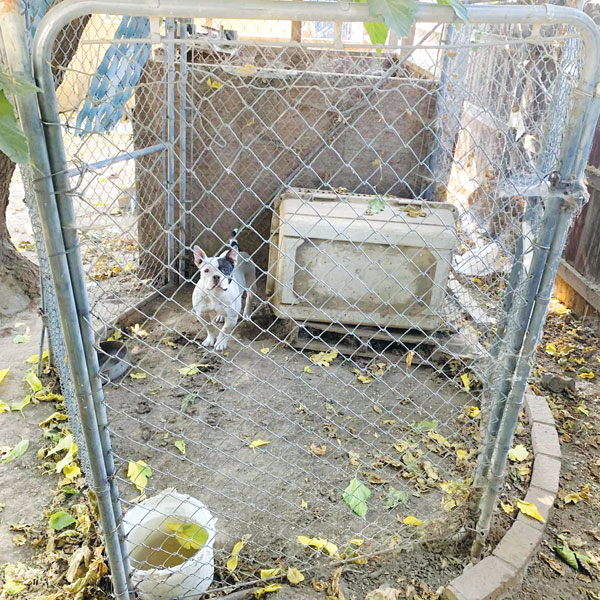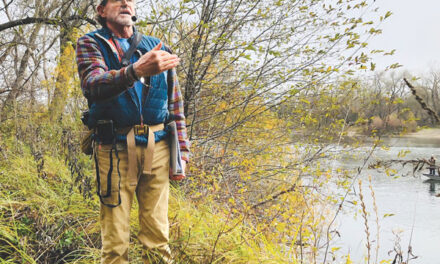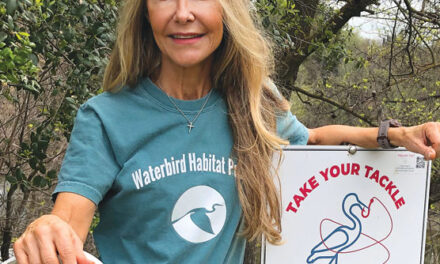Take a close look at the photo. Chain-link kennel, maybe 4 feet by 6 feet. Hardpan dirt. Feces underfoot. Empty food bowl. Filthy water dish. Solitary confinement. Here in Sacramento. And it’s legal.
My husband and I foster dogs for a local rescue group. In August on a 100-plus-degree day, I stood in the backyard of Becky Browning’s South Sacramento home. She had applied to adopt one of our foster mutts and I was performing a home visit.

Barks came from the other side of Browning’s back fence. I peered through a gap in the wood slats. There she was, alone in her barren kennel. A bow-legged, broad-chested, American pit bull terrier with white fur and a black patch around her left eye, much like “The Little Rascals” famous pup.
Browning told me her neighbor keeps the dog in the kennel 24/7. Browning and her adult daughter throw food over the fence and fill the water bowl with a hose.
She called the county about a month prior to report what she considered animal cruelty. A humane officer supposedly came out. Nothing changed.
“I don’t think it’s right,” Browning says. “She doesn’t have room to walk. She’s just confined to that little spot and that’s it.”
I dialed 311, the non-emergency number Sacramento city and county residents use to report issues such as abandoned vehicles, illegal dumping—and animal abuse and neglect. A call center agent politely took my complaint.
A few days later, a county humane officer visited the house. No one answered, so the officer left a standard notice telling the homeowner a humane complaint had been reported. That’s when I sent the photo to my contact at the county shelter, hoping it would spur more action. The opposite happened.
“The photograph shows no violations of law,” says Bill Davidson, supervising animal control officer for Sacramento County. He closed the case. The officer never went back.
“The kennel is more than adequate for the size of the dog,” Davidson says. “The water is definitely potable. There is some minor amount of algae growing on the sides of the bucket. But that is insignificant.”
Davidson went on to tell me about another “improper care violation” last summer where four dogs were kept in a kennel slightly larger than the one in the photo. There was a kiddie pool with “a thick layer of algae on the top that you could practically walk on. But because there was water available, the judge threw it out.”
I explained the only reason this dog had water was because the neighbor fills the bowl from over the fence. But providing water backfired.
“We tell people to report the problem, but don’t give it food. Don’t give it water,” Davidson says. “We have to be able verify that it’s not being cared for.” Apparently, a neighbor’s testimony is not enough. The animal must go without food and water until a humane officer can “verify” the crime.
According to the county’s website, it’s illegal in California to “leave pets unattended for extended periods of time: in vehicles in extreme weather; or without food and water” and to “deprive animals of necessary sustenance, access to water, shelter, veterinarian care, and adequate exercise.” California Penal Code 597t states, “Every person who keeps an animal confined in an enclosed area shall provide it with an adequate exercise area.” There is no statutory definition of “adequate exercise area.”
“Unfortunately, it doesn’t appear the dog is being neglected based upon the law, which sadly is a low bar,” says Celeste Ingrid with the county’s Bradshaw Animal Shelter. “The dog has water, ‘shelter’ and what appears to be a food bowl of sorts. No food is seen, but it doesn’t mean the dog isn’t being fed. These situations are so very sad and frustrating because the law is lenient.”
Browning later told me the pit bull was moved to a kennel behind the one in the photo. She can no longer see the dog. She cannot throw her food. She cannot fill her water bowl. But Browning intends to keep calling 311.
“At least 50 percent of animal owners in Sacramento County do the absolute bare minimum of what’s required,” Davidson says. “I can take anyone of those people and talk to them for two hours about why they shouldn’t own animals. But the bottom line is the law supports them in owning animals under those conditions.”
“It’s disheartening and frustrating,” he adds. “I get it from the public’s point of view. And trust me, I get it from my point of view all the time. But I am limited with what I can do.”
Here’s what I learned: A dog can live 24/7 in a small backyard kennel, with a minimum amount of human interaction, no ability to run, filthy water, in 100-plus degree heat. So I ask, how is this legal?
Cathryn Rakich can be reached at crakich@surewest.net. Follow us on Facebook, Twitter and Instagram: @insidesacramento















